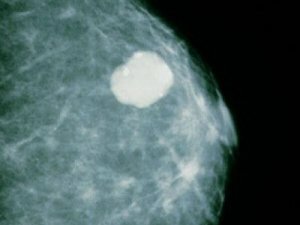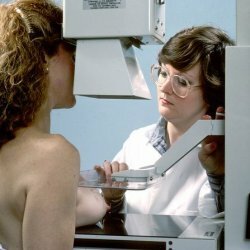Retracted nipples: correction and possible problems
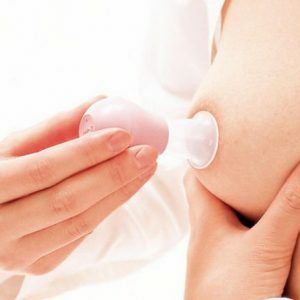
Pulled nipples are not only an aesthetic problem, but also a pathological condition that has quite certain signs and causes.In the absence of treatment, serious consequences may develop.
Table of Contents: General Information Why are the nipples retracted?Types and degrees Diagnosis Correction of retracted nipples Prognosis and preventionGeneral information
Retracted nipples of the breast are diagnosed in every tenth patient.In rare cases, the phenomenon can be observed in men in connection with the injuries or acquired disease.Sometimes the problem is of a genetic nature.
Important! To recognize the ailment is simple: the syndrome of the involved nipple is manifested by the absence of the latter over the areola.He can be with her on the same level or be pressed into the chest.Pathology develops on one or both mammary glands.
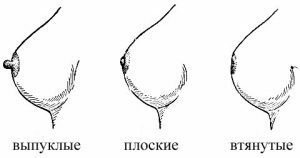
Psychological discomfort is not the only problem for a woman who has been diagnosed with this condition.She feels incomplete after the birth of the child at the time of breastfeeding, as it can not establish a natural process of breastfeeding.At best, milk constantly leaks, at worst - the process of capturing and holding the nipple in the infant's mouth is complicated, as a result of which pediatricians sometimes translate that into artificial feeding.
To all, the presence of a retracted nipple makes it difficult for women to communicate with the opposite sex.
Why are the nipples drawn?
The mechanism of pathology development is simple: the surface of the nipple is strewn with outlets of the milk ducts( from 15 to 25 pieces).The cavity between them is filled with connective tissue strands that hide in the deep layers of the breast.Normally, the connective tissue strands are of sufficient length to allow the nipple to rise above the areola.However, due to various reasons, they shorten, and the nipple retracts.Other reasons are replacement of connective tissue with fibrous or sclerotic formations, which also retract the nipple.
Please note! In medical practice, cases are known where breastfeeding promoted the stretching of the bundles and the return of the pacifier to its former position.
The main reasons for the development of the syndrome are:
-
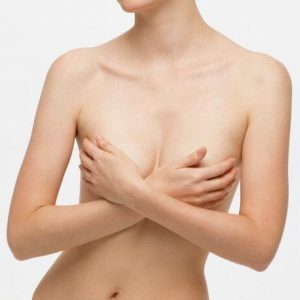 genetic predisposition - in this case the strands of connective tissue bundles are too short from birth;
genetic predisposition - in this case the strands of connective tissue bundles are too short from birth; - trauma of the mammary gland resulting from bumps, falls and bruises;
- abnormalities of growth of milk ducts;
- delays in mental or physical development;
- pathology of nipple development;
- Genetic diseases - for example, Weaver's syndrome, which is manifested by rapid growth;
- diseases of the mammary glands - purulent mastitis, which causes their deformation, papillomas of the milk ducts;
- breast cancer;
- wrong choice of underwear - narrow, uncomfortable, in case of prolonged wearing it promotes the development of pathology.
Species and degrees
For the first time the classification of the syndrome was suggested by the plastic surgeon Slosser.According to him, mammologists began to allocate:
- Concealing nipples.The condition is caused by physical effects on the mammary glands, for example, by their trauma, and usually does not need treatment.During sexual stimulation or during lactation, the nipples return to their seats.
- Inverted, or initially retracted.Are manifested as a result of congenital pathology and require correction.
The lack of appropriate treatment for the diagnosis of inverted nipples can result in their irritation or inflammation.
Important! Learning to distinguish hiding nipples from the initially drawn is not difficult.In the first case, a part of the nipple hides, forming a kind of gap with the areola.In the second, the nipple turns in the opposite direction.
The complexity of a state is determined by its degree.Doctors sing:
- the first degree at which the nipple is easily stretched with gentle pressure on the skin and even retains this state for several minutes;
- second, in which it is more difficult to extract, since it quickly returns back;
- is the third, in which no manipulation allows the pacifier to rise above the areola.
Diagnosis
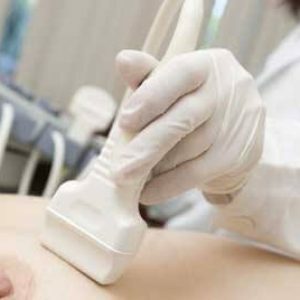 Diagnosis of the syndrome of the entrained nipples begins with examination of the mammary glands, because the defect is visible to the naked eye.Subsequently, the doctor may prescribe procedures for breast ultrasound, mammography, magnetic resonance imaging, sonography( before surgery), cytological examination of tissues and secretions from the chest.The results of these studies will confirm or deny the presence of concomitant diseases.
Diagnosis of the syndrome of the entrained nipples begins with examination of the mammary glands, because the defect is visible to the naked eye.Subsequently, the doctor may prescribe procedures for breast ultrasound, mammography, magnetic resonance imaging, sonography( before surgery), cytological examination of tissues and secretions from the chest.The results of these studies will confirm or deny the presence of concomitant diseases.
Breast phlebography is performed to exclude pathologies of axillary lymph nodes.
In addition, women are prescribed directions for:
- urine analysis;
- a clinical blood test;
- scraping;
- bacterial culture from the nipple to infection.
Correction of retracted nipples
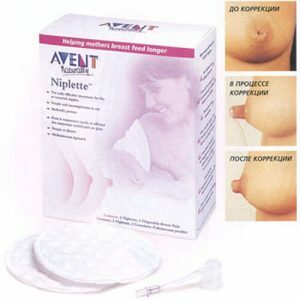 Treatment of retracted nipples can be therapeutic and surgical.The first is applied with timely access to a specialist and passes for a woman quickly and painlessly.The essence of therapy is the use of a special vacuum nozzle.It is superimposed on the mammary gland after preliminary lubricating the nipple with petroleum jelly.Ointment provides additional sealing.
Treatment of retracted nipples can be therapeutic and surgical.The first is applied with timely access to a specialist and passes for a woman quickly and painlessly.The essence of therapy is the use of a special vacuum nozzle.It is superimposed on the mammary gland after preliminary lubricating the nipple with petroleum jelly.Ointment provides additional sealing.
After that, air is pumped out of the nozzle, and it is fixed on the breast with a surgical plaster.Due to the fact that the patient does not remove the nozzle throughout the day and wears it for several weeks, the bundles of the bundles are lengthened and the nipple is stretched.From time to time, the doctor will remove it and inspect the damaged area for irritations and cracks.
Please note! If, after 3 to 6 weeks, the pathology does not go away, surgical treatment is prescribed.
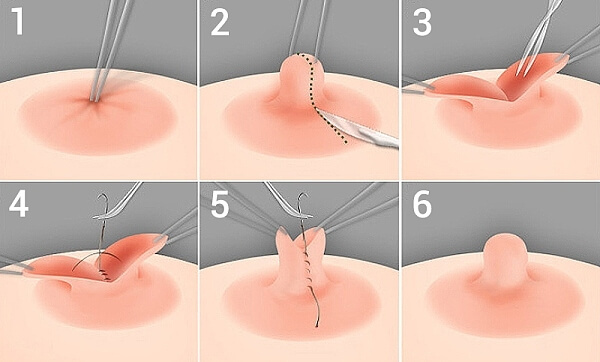
Before performing a plastic surgery to correct the retracted nipples, the specialist will ask the patient if she plans to continue breastfeeding.In the case of a positive response, he will strive to maintain the integrity of the dairy ducts, and in the case of a negative one, he will simply correct the cosmetic defect.
With the preservation of the functioning of the milk ducts, a microsurgical correction is performed, within which a small incision is made in the region around the nipple.Through it only connective tissue strands are dissected, the ducts remain intact.The accuracy of the operation is provided by using a microscope.Meanwhile, the positive effect of its conduct is observed only in 75 - 80% of cases.A simple correction of a cosmetic defect solves the problem in 95% of cases.
The operation takes about an hour.Puffiness and cyanosis can persist for a few more days, after which they pass without a trace, however, like seams.At first, the sensitivity of the nipples may decrease, but it soon returns again.
Important! To avoid negative consequences after plastic surgery, it is not recommended to perform heavy physical exercises, go to the solarium, to the sauna, to the beach for several months.
It is worth mentioning that a normal breast pump can stimulate the protrusion of the nipple, as well as sexual caresses that boil down to its rhythmic contractions.Meanwhile, completely rely on them to solve the problem is not necessary, because in some cases, the process of getting rid of the pathology can last for a period of 6 months to 5 years.In addition, it is not recommended to carry out such manipulations during pregnancy, as stimulation of the nipple provokes the tone of the uterus, which can result in miscarriage or premature birth.
Please note! When breastfeeding a woman may be advised to use a special cap, which is put on the nipple and facilitates the process of sucking for the baby.
Forecast and Prevention
 In most cases, the operation is successful.Sometimes on the mammary gland may occur post-operative scars.Rarely due to dissection, damage to the nerve endings occurs, which results in a decrease in sensitivity in the operated thoracic gland.
In most cases, the operation is successful.Sometimes on the mammary gland may occur post-operative scars.Rarely due to dissection, damage to the nerve endings occurs, which results in a decrease in sensitivity in the operated thoracic gland.
Prevention of the disease is reduced to regular examination by a mammologist and exclusion of oncology.
The syndrome of the entrenched nipples is a common phenomenon, which, when duly addressed to a specialist, is successfully treated.At the same time, the lack of competent medical care leads to the development of inflammation and serious diseases, for example, atelia, in which the nipple is completely absent.
Betsik Julia, obstetrician-gynecologist

